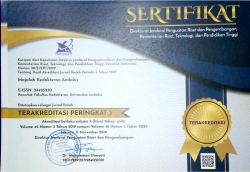Ekspresi Tumor Necrosis Factor-Alfa (TNF-α) dan Interleukin-10 (IL- 10) pada Infeksi Malaria Falciparum
Abstract
Abstrak
Malaria masih menjadi masalah kesehatan di dunia terutama negara tropis karena angka kesakitan dan kematiannya yang tinggi. Infeksi Plasmodium falciparum ini dapat menimbulkan gejala yang berat sampai kematian. Perbedaan perjalanan penyakit pada masing-masing individu salah satunya dipengaruhi oleh sistim imun. Di antara zat yang ikut berpengaruh pada imunitas malaria adalah TNF-α dan IL-10, yang dihasilkan oleh sistim pertahanan tubuh terhadap parasit ini. Tujuan penelitian ini adalah untuk mengetahui ekspresi TNF-α dan IL-10 pada infeksi malaria falciparum, menggunakan rancangan explanatory secara cross sectional, dan melibatkan 25 penderita malaria falciparum dengan umur berkisar 14 – 60 tahun. Kadar TNF-α dan IL-10 dianalisis dengan metoda enzyme-linked immunosorbent assay (ELISA), dan hasil analisis dinyatakan bermakna bila didapatkan p < 0,05. Penelitian menunjukkan adanya peningkatan kadar TNF-α dengan rerata 283,10 ± 267,72 pg/ml dan peningkatan kadar IL-10 dengan rerata 196,99 ± 131,94 pg/ml pada penderita malaria falciparum, yang dalam keadaan normal tidak terdeteksi. TNF-α berkorelasi positif dengan IL-10 (r = 0,491; p > 0,05), tapi berkorelasi negatif dengan kadar hemoglobin (r =-0,189; p > 0,05). IL-10 berkorelasi positif dengan kadar hemoglobin (r= 0,134; p > 0,05). Terhadap parasitemia, TNF-α berkorelasi positif (r=0,036; p > 0.05), namun IL-10 berkorelasi negatif (r = -0,043 dan p>0,05). Dari penelitian ini dapat disimpulkan bahwa infeksi malaria falciparum berpengaruh terhadap peningkatan kadar sitokin TNF-α dan IL-10.
Kata kunci : TNF α – IL 10 – malaria falciparum
Abstract
Malaria is still a universal health problem, especially in tropical countries because of its high morbidity and mortality rates. Infection by Plasmodium falciparum could result in severe symptoms or even death. Differences in pathogenesis among affected individuals are affected by many factors, and the immune system is one of them. Among substances involved in the malarial immunity is TNF-α and IL-10, produced by the body's defense system as the reaction to the parasite. The objective of this study is to find expression of TNF-α and IL-10 on falciparum malaria infection, using an explanatory cross-sectional design, involving 25 people with falciparum malaria with age ranging from 14 to 60 years. The presence of TNF-α and IL-10 were
ARTIKEL PENELITIAN
17
analyzed using enzyme linked immunosorbent assay (ELISA), and significant values considered at p < 0.05. The results show that there are increased rate of TNF-α with average 283.10 ± 267.72 pg/ml, and increased rate of IL-10 with average 196.99 ± 131.94 pg/ml among people with falciparum malaria, while in normal circumstances they are not detected. There is a positive correlation of TNF-α with IL-10 (r=0.491; p>0.05), but negative correlation with the rate of hemoglobin (r=-0189; p>0.05). IL-10 correlated positively with the rate of hemoglobin (r=0.134; p>0.05). TNF-α is positively correlated with parasitemia (r =0.036; p>0.05), but IL-10 is negatively correlated (r =-0043 and p>0.05). The results from this study conclude that falciparum malaria infection increases of TNF-α and IL-10 cytokine.
Keywords: TNF α – IL 10 – falciparum malaria





















